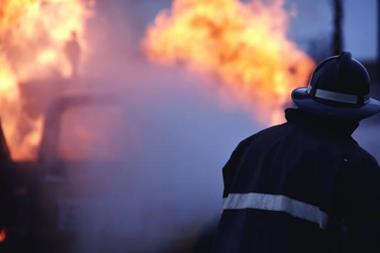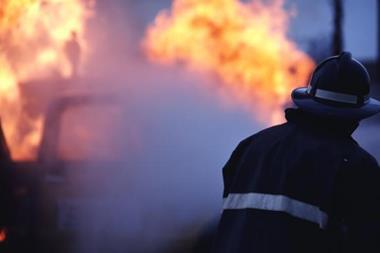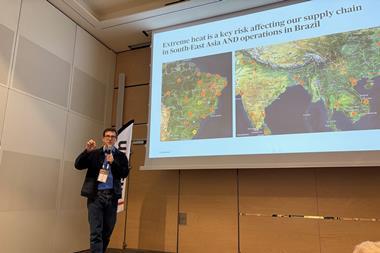Is current industry practice in fire risk assessment enough to meet the forthcoming regulation in this area? Not according to Dr Jason Clement, who says companies are missing out on the full benefits
On 12 January 2006 the Government announced that it has put back the implementation date for the Regulatory Reform (Fire Safety) Order 2005 (RRO). When implemented, this new statutory fire safety regime will affect virtually all non-domestic premises in England and Wales. Near identical legislative requirements are also due to come into effect in Scotland under the Fire Safety (Scotland) Regulations 2006 and the Fire (Scotland) Act 2005.
Both of these new statutory instruments place the burden of proof for demonstrating the adequacy of fire safety provision squarely onto the responsible person for the premises. Failure to comply with the legislation will expose the responsible person, in the form of both the corporate body and responsible individuals within it, to potential fines and up to two years imprisonment.
The RRO rationalises and consolidates the requirements of more than 100 pieces of existing workplace fire safety legislation into a single modern fire safety regime for non-domestic premises. In line with UK health and safety legislation, the RRO will require a risk-based management system for ensuring that adequate fire safety provision is provided for the protection of all relevant persons. Accordingly, under the Order, the responsible person will be required to provide and maintain general fire precautions based upon a suitable and sufficient fire risk assessment.
But are current industry practices in fire risk assessment really suitable to measure up to the intentions of the new legislation? Moreover, do they constitute an effective method for those businesses which are seeking an efficient means to reduce their overall fire risk?
Current industry practice
Current industry practice in conducting fire risk assessments is generally founded on a checklist template. The template will typically list a multitude of factors that can contribute to the risk of people being harmed by the effects of fire. In applying the risk assessment template to premises, the risk assessor evaluates each factor that is relevant to the premises under consideration. More often than not the evaluation of each factor is simply a true/false determination that confirms the existence of specific hazards and risk control measures.
Where possible, depending upon the competency of the risk assessor, the adequacy of risk control measures will be evaluated through benchmarking against the nationally accepted standard. For example the circulation and egress facilities in a building may be benchmarked against the prescriptive requirements for means of escape in Approved Document B of the Building Regulations. Not surprisingly, this approach often generates recommendations that are focused on bringing risk control measures into compliance with the nationally accepted standards.
Once each factor on the checklist has been assessed, the overall acceptability of the fire safety risk is typically determined based upon an indefinable summation of the contributory assessments. The end result is a determination of whether or not the risk to life from fire in the building is acceptable.
Some fire risk assessment methods have attempted to advance this practice by categorising the overall fire safety risk according to a matrix of likelihood versus consequence. The determination of the qualitative measures for likelihood and consequence is still however founded upon some intuitive assimilation of the assessments made for all the contributory factors.
Herein lies one of the primary weaknesses of current fire risk assessment practice; a lack of structured method for determining conclusions. This deters businesses from conducting their own fire risk assessments, and thereby they forfeit the potential benefits of having in-house competency in fire risk assessment (as discussed later).
Typically, fire risk assessments are conducted across the site as a whole. However some practitioners subdivide the site into zones and then conduct a fire risk assessment on each zone independently.
Actual fire safety risk
Consider the reality of fire safety risk within buildings. Inevitably within any building there are going to be specific locations where the fire safety risk for occupants may be regarded as high, relative to other areas within the building. A characteristic example of this could be a noisy basement plant room with only a single means of escape.
Similarly, just as fire safety risk varies with location on site, the risk also varies as the operating conditions or the occupancy characteristics on site change. Consider for example the short time interval each year when sprinklers are isolated in order to service the installation valve sets; over this period the risk for the site is temporarily heightened.
In reality then, the fire safety risk within any site varies according to location and occupancy conditions.
Shortfalls in current practice
A suitable fire risk assessment methodology should therefore be capable of capturing the variation in the fire safety risk in order to reflect reality. If the risk assessment method is incapable of capturing an apt depiction of the risk then there seems good reason to question the value of the exercise.
Consider the current industry practice of evaluating the overall fire safety risk for an entire site. The very nature of this approach prohibits the risk assessment from determining high risk locations within the premises.
This shortfall can be addressed to some extent by subdividing the site into different zones and then conducting an assessment on each zone independently.
This enables the risk on site to be mapped according to the zoning. However, due to the objectives of current fire risk assessment methodologies, the precision of the mapping is usually limited to presenting either acceptable or unacceptable zones of risk, as opposed to presenting areas of low, moderate, high and extreme risk, for example. Not surprisingly, in practice it is unusual for risk assessments to conclude unacceptable fire safety risk, so that in reality there is no demarcation between the different levels of risks that exist across site, even when assessed zone by zone.
The practice of subdividing the site into different zones and then conducting a fire risk assessment on each zone independently is, however, subject to a more fundamental and serious shortfall than simply the limited precision of the risk mapping. By assessing each zone independently, the risk assessor overlooks the fact that occupants in that zone may be threatened by fires that occur elsewhere in the building. The importance of this threat has been clearly illustrated by fire safety tragedies such as the MGM Grand Hotel fire in 1984 and the Dusseldorf Airport Terminal fire in 1996. In both tragedies the bulk of fatalities occurred in areas that were well away from the area involved in fire.
Suitability of current practice for the forthcoming legislation
Article 9 of the RRO requires that the responsible person record 'any group of persons identified by the assessment as being especially at risk'.
This legislative requirement, whether intending to do so or not, acknowledges that the fire safety risk on site varies. For reasons highlighted previously, this brings into question the suitability of current industry practice in fire risk assessment. Fire risk assessments will need to be capable of differentiating the various levels of risk that occur on site, so that groups of people especially at risk can be identified.
There is also a potential problem associated with the interpretation of this legislative requirement. If the term 'especially at risk' is interpreted to mean 'exposed to unacceptable risk' then in practice risk assessors are unlikely to record any group of persons under this category. This would be counterproductive to good risk management practice, as a suitable and sufficient risk assessment delivers an understanding of the extent and magnitude of risk exposures on site, and thereby provides guidance for decision making on cost-effective risk control.
A more beneficial interpretation of this phrase would be to consider it as 'any group of persons identified by the assessment as being in the high risk situations on site'. This interpretation implies that the risk is a relative measure, whereby the assessor is required to record the locations or occupancy conditions that generate the highest risks on site.
This interpretation then leads the assessor to compile a prioritisation listing of the risks on site.
Unfortunately if the enforcement authorities choose to apply the former interpretation, then it is foreseeable that the benefits of good fire risk assessment practice will be undermined by the desire for simple checklist enforcement practices.
Effective assessment underpins cost-effective risk reduction
A fire risk assessment that differentiates between the different levels of risk provides guidance on where, and to what extent, risk control measures are required, and indeed, on the most cost effective form of risk control.
Ideally, for reliability, engineered risk control measures would be implemented for all those risks that cannot be avoided. However, to provide an acceptable level of safety across the entire site at all times, the engineering control measures would need to be appropriate for the highest risk that could possibly occur. This blanket approach is not generally cost effective, as the peak risks are often temporary occurrences. A more economic approach is to provide engineered risk controls appropriate to a specific level of risk on site, and then superimpose human element risk control programmes on top of these static measures to address temporary periods when the risk is heightened. Examples of this approach include the hot work permit system, system impairment notifications, and prioritised emergency response procedures.
Benefits - the true value of internal competency
Within the general approach outlined above it is common to find that temporary periods of heightened risk are addressed via human element risk control measures. The effectiveness of this form of risk control is deeply dependent upon the degree of understanding on the part of the individuals involved. Staff members with fire risk assessment competency are well placed to recognise periods when the fire safety risk is temporarily heightened.
Further, these individuals understand the value and principles of the human element risk control measures, thereby raising the reliability.
Although the RRO is specifically concerned with protection of life, risk control measures implemented for compliance purposes also deliver value in term of protection of assets and continuity of business operations.
Accordingly, any improvement in the reliability of risk control delivers value to the protection of business interests, and in theory should reduce the probable cost of fire losses. For this reason the cost of providing staff training in fire risk assessment needs to be considered against the direct benefit of improved risk control, the increased appeal of the property and business interruption risk to insurers, and the intangible benefits of reduced fire losses. Further, recalling that fire safety risk varies with changes in operating conditions, it is evident that a snap-shot assessment conducted by a third party cannot capture a true assessment of the risks on site. This is acknowledged in Article 18 of the RRO, which requires that where there is a competent person within the responsible person's employment, that person must be appointed in preference to an external competent third party.
Dr Jason Clement is a consultant with the property risk consulting team at Marsh. For more information on the firm's RRO or fire safety risk management training courses, contact jason.clement@marsh.com
WHO IS RESPONSIBLE?
Responsibility for complying with the Fire Safety Order will rest with the 'responsible person'. In a workplace, this is the employer and any other person who may have control of any part of the premises, for example the occupier or owner. In all other premises the person or people in control of the premises will be responsible. If there is more than one responsible person in any type of premises, all must take all reasonable steps to work with each other.
Find Government information on the new Order at www.odpm.gov.uk/index.asp?id=1124877






























